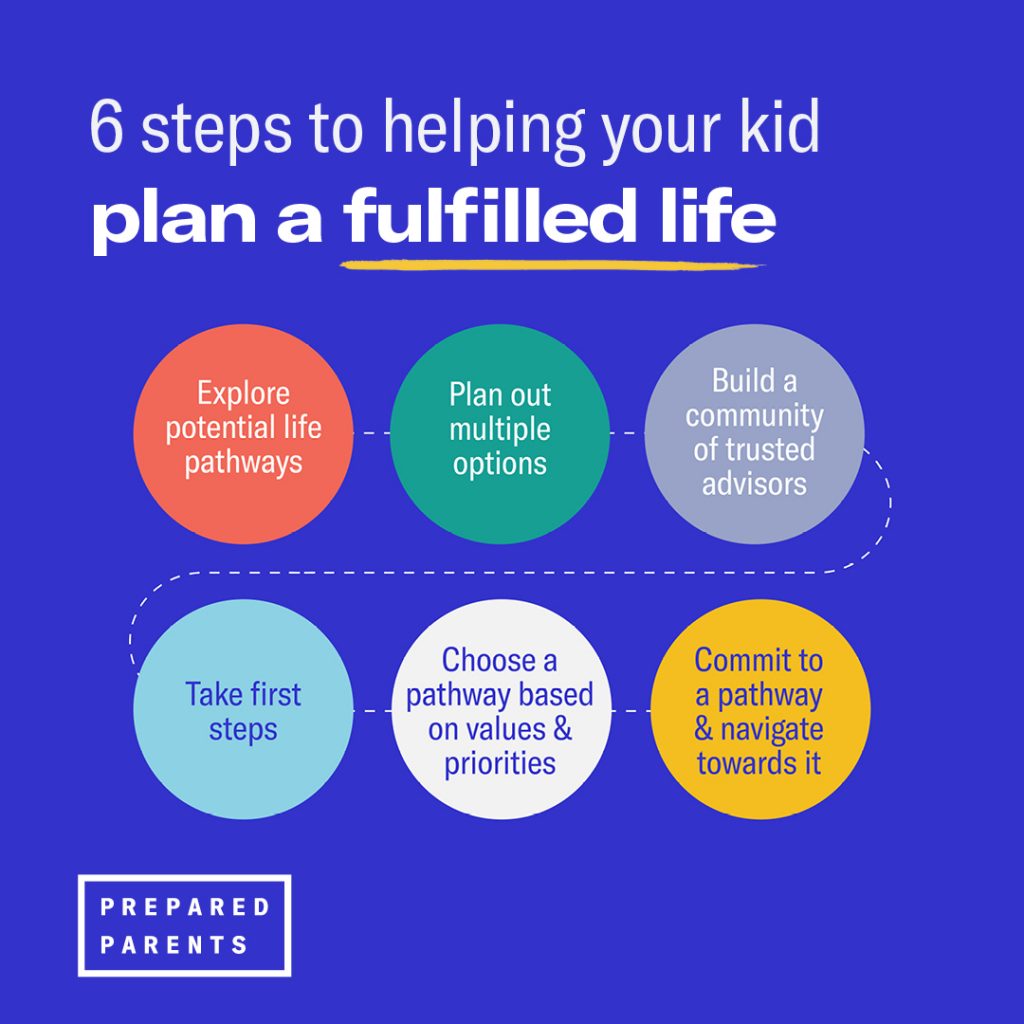It can be easy to fall into the trap of thinking that getting into a “good” college is the goal of our kids’ learning. Unfortunately, placing the finish line at the end of high school creates a path for our kids that doesn’t necessarily serve them in the long run. What if instead of college admission, we focused on lifelong fulfillment?

Finding your kid’s best fit for life after high school comes from pursuing goals that are aligned with their vision of fulfillment. In other words, our kids can be working toward career goals that follow their interests and purpose—and that are realistic.
It could be a circuitous journey, but it’s more likely to lead to a fulfilling future. Imagine your kid:
- exploring potential life pathways,
- planning out multiple options,
- building a community of trusted advisors,
- taking first steps,
- choosing a pathway based on their values and priorities, and
- committing to a pathway and starting to navigate towards it.
“Purpose gives you a long-term compass that keeps you on track,” says Bill Damon, director of the Stanford Center on Adolescence. “Purpose is associated with lots of benefits, ranging from health to energy, to a sense that I’m satisfied with my life, and I’m finding fulfillment in my everyday actions.”
Purpose is one of the top three habits (along with Curiosity and Self-direction) named by Dr. Brooke Stafford-Brizard and Turnaround for Children that set kids up for success in school and in life. It is an essential skill that helps people of all ages pursue interests, develop new skills, find meaning, and contribute to the world around them.
Purpose is central to our kids’ fulfillment—including their physical and mental well-being—so it’s something we should nurture as early as possible. “People with a Sense of Purpose know who they are,” says Diane Tavenner, author of Prepared: What Kids Need for a Fulfilled Life and co-founder and CEO of Summit Public Schools. “They know what their values are. They know what motivates them. They understand what society has to offer them, and they take advantage of opportunities to make choices that are aligned with who they are.”
Start young
No need to wait until high school to start considering options for finding purpose. Purpose starts with interest. Pay attention to what your kid pays attention to. The kid who enjoys drawing, may become a UX designer. The penny pincher might choose investment banking. When you see an interest, nurture it. Take the artist to the museum. Open a savings account for the budding financier. If your kid loves animals, volunteer together at the local humane society. When you see a spark ignite, help your kid to recognize what that means about them. This self-awareness can fuel their future choices. Make a list of what you observe them getting excited about, and you’ll start to see a pattern emerge that may identify that road they’ll eventually set off on.
Use 1:1 time to reflect together
Set aside some 1:1 time to talk together about what makes them curious. Dig deeper into your kid’s interests with probing questions like:
- I notice you enjoy reading history. Tell me more about that.
- You seem to like putting your outfits together. Are you interested in learning more about fashion?
- The school projects that take most of your attention are science-based. What is it about the process that intrigues you?
Tell your story
How did you discover your passion? What roads did you take to end up where you are today? Is there a different road you wish you’d taken? Share your story and be vulnerable. You’re making a safe space for your kid to tell you what they’re really interested in
Take your kid to work
Leverage your experience to introduce options. Even if they’re not interested in your career, you’re exposing them to a work environment. It’s a chance to speak with your colleagues and learn about how many different opportunities exist within one organization. That may open them up to even more ideas about what they may enjoy pursuing.
Encourage several options
Multiple path planning not only lowers anxiety, it builds confidence and resilience. When there’s a back-up plan, it’s easier to move forward with life. Advise your kid to come up with three alternate plans that include:
- A timeline
- The requirements to achieve the goal including degrees, certificates, and experience
- A budget to get there
- A list of their skills and passions that align with the opportunity
- The reason why this path is a good fit
Be a dreamweaver
Kids need to mentally build a picture of themselves doing different things. Even if their concrete next step is to play for the NBA or star in an Academy Award-winning movie, don’t discourage them. Do ask what it is about these dreams that interest them and align with their vision of who they want to become. Encourage them to dig deep by asking, what’s the best part of your dream and is this something you can actually see yourself doing? Continue the conversation to unpack more details. In doing so, they may hone in on even more areas of interest. Help them to recognize that in order to reach a big goal, they’ll have to take obstacles into account and plan for how to overcome them.
Be a cheerleader
Love and passion are great motivators. So is your encouragement. Embrace their interest and cheer them on. Point out accomplishments and small wins they’ve achieved to advance forward. Support them and walk with them through the process to try on different interests.
A kid who understands the intersection between who they are, what they’re passionate about, and what they can do is building the concrete next step to find a best-fit for their future.

